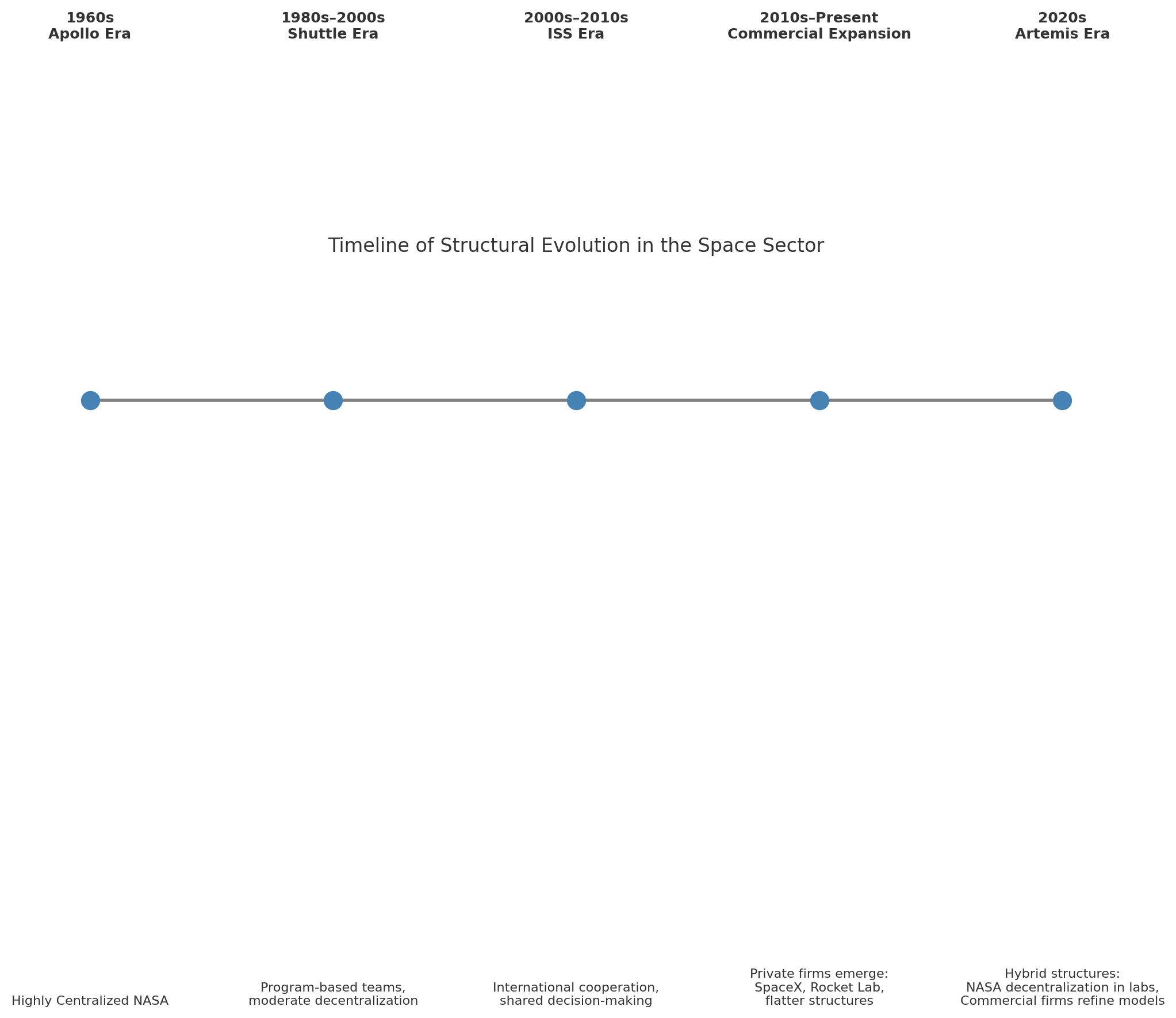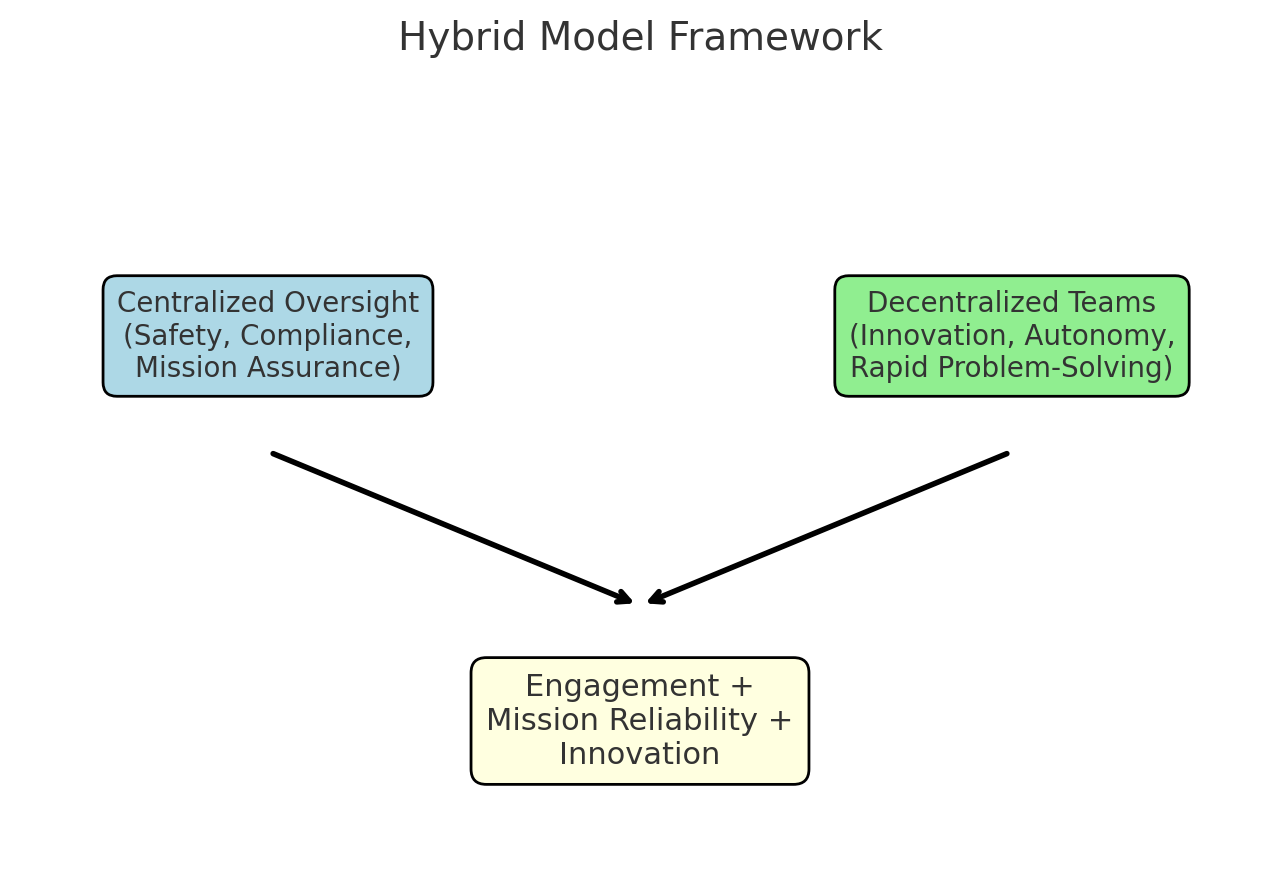Decentralization and Engagement in the Space Sector
Executive Summary
Space exploration is one of the most complex and high-stakes industries in existence. Organizations in this sector face the dual challenge of maintaining reliability and safety while fostering innovation and speed. This case study examines how decentralized organizational structures influence employee engagement across both government agencies such as NASA and ESA and commercial firms such as SpaceX, Blue Origin, and Rocket Lab.
Decentralization distributes decision-making authority across organizational layers, empowering teams and individuals. Research shows this often increases engagement, innovation, and ownership (Boemelburg et al., 2023; Jang & Kim, 2025). Yet decentralization also carries risks: decision overload, coordination failures, and burnout. For high-reliability sectors such as space, the solution is a hybrid model: centralized oversight for safety-critical functions paired with decentralized autonomy for innovation-driven work.
Key Takeaways
- Decentralization enhances engagement by fostering autonomy and ownership.
- Performance pressure constrains autonomy if not balanced with resources and support.
- Government agencies (NASA, ESA) thrive with hybrid structures: centralized assurance plus decentralized labs/teams.
- Commercial firms (SpaceX, Rocket Lab) maximize innovation through decentralization but risk burnout and cultural fragility.
- Optimal space-sector design: hybrid structures blending accountability with empowerment.
Introduction
Organizational structure is not simply an administrative choice; it is the architecture through which strategy, innovation, and human engagement are channeled. Within organizational behavior (OB), structure defines how decisions are made, how information flows, and how employees experience meaning in their work. Among the design choices available to leaders, decentralization—defined as the systematic delegation of decision authority downward in the hierarchy—has become a focal point for industries where complexity and uncertainty demand agility.
The space sector epitomizes such conditions. Missions are multi-decade, technologically complex, and safety-critical. The Apollo program (1960s) operated under extreme centralization, necessary for speed and political urgency. In contrast, today’s environment features government agencies balancing scientific exploration with accountability to stakeholders, and commercial firms competing aggressively in launch, satellite, and exploration markets. In this context, the question of structure is not theoretical. It directly influences whether organizations can sustain the engagement of their highly skilled engineers, scientists, and operators—the very lifeblood of space innovation.
This case study addresses the question: How do decentralized organizational structures influence employee engagement in the space sector? Using a balanced case analysis approach, it synthesizes literature, theory, and practice to provide a comprehensive assessment.
Background: Decentralization in Organizational Behavior
Decentralization has been debated since the earliest OB theories. Max Weber’s bureaucratic model emphasized centralized authority and clear hierarchies as guarantors of rationality and efficiency. Taylor’s scientific management also privileged centralized control, arguing that managers should design processes while workers executed them. These frameworks worked well for industrial production but were less suited to innovation-driven contexts.
By the mid-20th century, organizational theorists such as Chester Barnard and later Herbert Simon argued that decision-making could not be monopolized by the top of the hierarchy; instead, expertise resided at multiple levels. This shift became more urgent in knowledge-intensive industries, leading to contingency theory in the 1960s and 70s, which argued that the best structure depends on environmental context.
In the space sector, decentralization intersects with another tradition: high reliability organizing (HRO). NASA and ESA operate under conditions where failure can be catastrophic. HRO theory suggests that organizations must simultaneously empower local expertise and centralize critical safety decisions. Thus, decentralization in space is never absolute—it is always balanced.
Theoretical Foundations
Self-Determination Theory (SDT)
According to Deci and Ryan’s SDT, engagement is maximized when three psychological needs are met: autonomy, competence, and relatedness. Decentralized structures directly support autonomy, allowing employees to shape their work. When paired with competence (adequate resources, mastery) and relatedness (connection to mission and colleagues), engagement flourishes. In space organizations, autonomy without competence (e.g., underfunded projects) produces frustration, while autonomy without relatedness produces disengagement.
Ambidexterity
James March (1991) distinguished between exploration (innovation, risk-taking) and exploitation (efficiency, refinement). Ambidexterity refers to the organizational ability to do both. Decentralization encourages exploration, while centralization supports exploitation. Space organizations must balance both: Apollo required exploitation of known processes, while Artemis requires exploration into uncharted technology.
Contingency Theory
Contingency theory asserts that no single structure is universally optimal; instead, effectiveness depends on environmental conditions (Lawrence & Lorsch, 1967). For stable, predictable industries, centralization may be sufficient. For volatile, innovation-heavy industries such as space, decentralization offers advantages—but only when buffered by coordination systems.
Kahn’s Engagement Model
Kahn (1990) defined engagement as the harnessing of organizational members’ selves to their roles. He identified meaningfulness, safety, and availability as conditions for engagement. Decentralization supports meaningfulness through ownership, but psychological safety must be protected: employees must be able to fail constructively. Availability depends on resources and organizational support.
Literature Integration
Boemelburg et al. (2023): Structure and Ambidexterity
Boemelburg et al. (2023) conducted a multilevel study showing that decentralized organizational structures positively influence employee ambidexterity. Employees in decentralized contexts demonstrated greater capacity to balance exploration and exploitation when climates encouraged adaptability. For the space sector, this validates decentralization’s role in fostering dual capacity: rapid iteration (e.g., SpaceX) and disciplined reliability (e.g., NASA Artemis safety protocols).
Jang & Kim (2025): Autonomy under Pressure
Jang & Kim (2025) found that autonomy boosts engagement and innovation, but performance pressure can constrain autonomy’s benefits. In organizations with extreme deadlines, employees may interpret autonomy as an increase in personal liability rather than empowerment. This resonates with accounts of engineers at SpaceX facing burnout during high-stakes launch windows.
Cao et al. (2025): OB Meta-Trends
Cao et al. (2025) mapped OB research trends across industries, finding decentralization and engagement to be recurring concerns. Their bibliometric analysis situates space organizations within a broader landscape: decentralization is not unique to space but part of a systemic shift toward empowering employees in competitive, innovation-driven fields.
Government Space Agencies
NASA
NASA exemplifies the tension between centralization and decentralization. During Apollo, structure was rigid and centralized—President Kennedy’s deadline required command-and-control. By contrast, the Shuttle era institutionalized bureaucracy, which slowed adaptation but ensured safety. Today, NASA employs a hybrid model. Labs such as JPL operate with high autonomy, while mission assurance processes remain centralized. For example, the Mars Rover projects empowered engineers to experiment locally, yet final launch decisions were tightly controlled.
ESA
ESA is inherently decentralized due to its multinational governance. Decision-making authority is distributed among member states, project directors, and contractors. This fosters engagement via ownership but introduces coordination challenges. The Galileo satellite navigation program exemplifies both strengths (collaborative innovation) and weaknesses (delays due to political bargaining). ESA demonstrates how decentralization is not always a design choice but sometimes a geopolitical necessity.
Commercial Space Firms
SpaceX
SpaceX is the archetype of decentralization in practice. Engineers are empowered to iterate quickly, decisions are made close to problems, and the culture prizes speed. Engagement is high, as employees feel directly tied to mission outcomes. However, reports indicate significant burnout: long hours, relentless schedules, and high-pressure leadership diminish sustainability. Autonomy without sufficient safety nets risks disengagement over time.
Blue Origin
Blue Origin combines decentralization within teams with overall cultural secrecy. While engineers enjoy autonomy, strategic direction is tightly controlled. Engagement stems from mission-driven work, though innovation cycles are slower than at SpaceX. The firm illustrates how decentralization can be tempered by leadership philosophy.
Rocket Lab
Rocket Lab operates at smaller scale, using flat structures to maximize agility. Employees see their contributions directly shape outcomes, driving engagement. Yet limited resources constrain the benefits of decentralization. For smaller firms, autonomy is double-edged: it empowers but also exposes capacity gaps.
Comparative Analysis

Timeline of Structural Evolution in Space Sector

Challenges and Risks of Decentralization
- Burnout: Autonomy combined with relentless pressure can exhaust employees (noted in commercial firms).
- Decision Overload: Too much choice without boundaries overwhelms teams.
- Communication Gaps: Decentralized teams risk siloing unless supported by integration mechanisms.
- Fragmentation: Excess independence can erode cohesion and mission focus.
- Cultural Drift: Decentralization without clear values risks diverging norms.
Hybrid Model Framework

This framework illustrates how centralized oversight for safety and compliance integrates with decentralized teams for innovation and autonomy, producing sustainable engagement and mission reliability.
Cross-Industry Comparisons
Space is not unique. Aviation balances autonomy of pilots with centralized air traffic control. Nuclear energy requires centralized safety standards with decentralized plant-level decision making. Defense systems use mission command: centralized intent with decentralized execution. These industries confirm that decentralization enhances engagement only when buffered by central coordination.
Lessons Learned and Recommendations
- Balance Autonomy with Support: Provide resources so autonomy is empowering, not overwhelming.
- Hybrid Structures Work Best: Centralize assurance, decentralize innovation.
- Manage Pressure: Recognize that autonomy loses effectiveness under unsustainable stress.
- Foster Psychological Safety: Encourage constructive failure.
- Contextualize Structure: Adapt decentralization to mission, risk profile, and culture.
Conclusion
Decentralization positively influences engagement in the space sector by enhancing autonomy, innovation, and ownership. Yet decentralization alone is insufficient. Without safeguards, it produces burnout, overload, and fragmentation. The optimal solution is hybrid structuring: centralized oversight for safety-critical domains and decentralized autonomy for innovation-driven work.
This conclusion aligns with both theory and evidence. Self-determination theory highlights autonomy’s role in engagement. Ambidexterity theory underscores the need for both exploration and exploitation. High reliability organizing reminds us that safety cannot be decentralized. Case analysis confirms that NASA, ESA, SpaceX, Blue Origin, and Rocket Lab all grapple with this balance in different ways.
For future space missions—Artemis, Mars exploration, commercial lunar operations—engagement will determine organizational resilience. The capacity to design structures that empower without fragmenting, that innovate without burning out, and that centralize without suffocating will define success.
References
- Boemelburg, R., Berger, S., Jansen, J. J. P., & Bruch, H. (2023). Regulatory focus climate, organizational structure, and employee ambidexterity: An interactive multilevel model. Human Resource Management, 62(5), 701–719. https://doi.org/10.1002/hrm.22155
- Jang, E., & Kim, Y. C. (2025). Autonomy constrained: The dynamic interplay among job autonomy, work engagement, and innovative behavior under performance pressure. Administrative Sciences, 15(3), 97. https://doi.org/10.3390/admsci15030097
- Cao, Y., Raab, C., & Bergman, C. (2025). Mapping the landscape of restaurant research: A bibliometric analysis of consumer behavior, organizational behavior, and finance studies. Businesses, 5(1), 11. https://doi.org/10.3390/businesses5010011
- Deci, E. L., & Ryan, R. M. (1980). Self-determination theory. New York: Plenum.
- Kahn, W. A. (1990). Psychological conditions of personal engagement and disengagement at work. Academy of Management Journal, 33(4), 692–724. https://doi.org/10.5465/256287
- March, J. G. (1991). Exploration and exploitation in organizational learning. Organization Science, 2(1), 71–87. https://doi.org/10.1287/orsc.2.1.71
- Lawrence, P. R., & Lorsch, J. W. (1967). Organization and environment: Managing differentiation and integration. Harvard University Press.
- NASA. (2019). NASA Organizational Structure Overview. NASA.gov. https://www.nasa.gov/sites/default/files/atoms/files/nasa_org_chart.pdf
- European Space Agency. (2022). ESA Governance and Structure. ESA.int. https://www.esa.int/About_Us/Corporate_news/ESA_structure
- McKinsey & Company. (2021). The new possible: How decentralization drives innovation. McKinsey.com. https://www.mckinsey.com/business-functions/organization/our-insights/the-new-possible
- Deloitte Insights. (2020). Designing resilient organizations. Deloitte.com. https://www2.deloitte.com/insights/us/en/focus/human-capital-trends/2020/organizational-resilience.html
